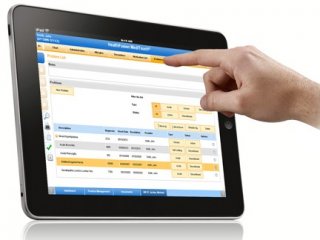
- Description
- Objectives
- Outline
- Materials
- Certification
- System Requirements
- Watch a Demo
Our Electronic Health Records Specialist program will help you gain a better understanding of both the terminology of the EHR systems and the practical use of such systems in a health care provider office setting.
Medical Terminology
Quickly master the basics of medical terminology and begin speaking and writing terms almost immediately! This course omits time-consuming, nonessential information and helps you build a working medical vocabulary of the most frequently encountered suffixes, prefixes, and word roots. Medical terms are introduced in the context of human anatomy and physiology to help you understand exactly what they mean, and case studies, vignettes, and activities demonstrate how medical terms are used in practice.
Prerequisite(s): None
Electronic Health Records
The nation's health care delivery system is rapidly being transformed by the introduction of computer-based health information systems - specifically, by electronic health records (EHRs). This Electronic Health Records course answers the need for health care students to understand the entire medical office workflow process, from scheduling an appointment with the doctor to collecting the final payment. Also included in our course is the clinical staff’s use of a point-of-care electronic health record. Included in our course is the detailed use of SimChart’s fully integrated electronic health record and practice management system. SimChart’s simulations allow students to practice each of the medical office workflows steps. Our Electronic Health Records course provides you with techniques and rationales for using electronic health records in practice and shows how the electronic health record affects your responsibilities on the job.
When you begin your career in the health care workplace, it is important that you have a clear understanding of EHR. The knowledge and experience gained through this course will be a vital component of the skills and competencies needed in the 21st century medical workplace.
Prerequisite(s): None
** Course Subject to Change.
Medical Terminology
After completing this course, you should be able to:
- Identify how to gain and understand the basic word structure in medical terminology
- Recognize how to relate the medical terms to the structure and function of the human body
- Identify body systems, body cavities, and planes of the body
- Define words by dividing them into their component parts
- Recall the terminology used with medical specialists and case reports
Electronic Health Records
After completing this course, you should be able to:
- Identify the developmental challenges associated with creating electronic health records
- Define electronic health record and its advantages and disadvantages
- Recognize the importance of patient data privacy
- List the steps for basic coding techniques
- Name the steps for documenting in the EHR
Medical Terminology
Medical Terminology Module 1
Basic Word Structure
- Word Analysis
- Combining Forms
- Suffixes & Prefixes
- Pronunciation of Terms
- Exercises & Applications
Medical Terminology Module 2
Organization of the Body
- Body Systems and Cavities
- Divisions of the Back
- Planes of the Body
- Pronunciation of Terms
- Exercises & Applications
Medical Terminology Module 3
Suffixes
- Introduction to Suffixes
- Suffixes and Terminology
- Diagnostic & Procedural Suffixes
- Pronunciation of Terms
- Exercises & Applications
Medical Terminology Module 4
Prefixes
- Combining Forms & Prefixes
- Prefixes and Terminology
- Define Common Prefixes
- Pronunciation of Terms
- Exercises & Applications
Medical Terminology Module 5
Medical Specialists & Case Reports
- Medical Specialists
- Combining Forms & Vocabulary
- Case Reports & Terminology
- Pronunciation of Terms
- Exercises & Applications
Medical Terminology Module 6
Body Systems – Part 1
- Cardiovascular System
- Digestive System
- Endocrine System
- Female Reproductive System
- Lymphatic System
Medical Terminology Module 7
Body Systems – Part 2
- Male Reproductive System
- Musculoskeletal System
- Nervous System
- Respiratory System
- Skin & Sense Organs
- Urinary System
**Outlines are subject to change, as courses and materials are updated.**
Electronic Health Records
Electronic Health Records Module 1
Introduction to the Electronic Health Record
- What is a Health Record?
- Who Documents in the Health Record?
- Who Owns the Health Record?
- The Electronic Health Record
- Advantages of Electronic Health Records
- Disadvantages of Electronic Health Records
- Role of the Healthcare Professional Using the Electronic Health Record
- Professional Organizations
Electronic Health Records Module 2
Overview of SimChart
- The Medical Practice and Electronic Health Records
- Accessing SCMO Through Evolve
- Getting Comfortable with Electronic Health Records
- SCMO Assignment View
- Features in SCMO
- Establishing and Maintaining a Patient Registry
- Internet Use in the Medical Practice
Electronic Health Records Module 3
Privacy, Confidentiality and Security
- HIPAA Law
- Confidentiality vs. Privacy
- Security Safeguards for the Medical Practice
- Patients’ Rights Under HIPAA
- Access to Protected Health Information
- Patients Protecting Health Information
Electronic Health Records Module 4
Administrative Use of the Electronic Health Record
- Role of the Front Office Assistant
- Communication in the Medical Office
- Incident Reports
- Managing Electronic Health Records
- Calendar
Electronic Health Records Module 5
Clinical Use of the Electronic Health Record
- Documentation in the Electronic Health Record
- Clinical Documentation in the Patient Record
- Tracking Health Screenings and Immunizations
- Using the Electronic Health Record for Patient Education
- The Progress Note
Electronic Health Records Module 6
Using the Electronic Health Record for Reimbursement
- Healthcare Reimbursement
- Revenue Cycle
- Coding Systems
- HCPCS
- Pay for Performance
- SuperBill
- Patient Ledger
- HIPAA 5010 Claim Processing
- Medical Necessity
- Fraud and Abuse
- Patient Statements
- Reporting Features of an EHR
Electronic Health Records Module 7
The Personal Health Record and Patient Portals
- What is a Personal Health Record?
- Innovative Features of Personal Health Records
- Benefits to Providers
- Steps in Creating the Personal Health Record
- Maintaining the Personal Health Record
- Patient Portals
**Outlines are subject to change, as courses and materials are updated.**
Ed4Career is committed to being both environmentally conscious and making it easier for you to study! We’re making your education mobile! All of our textbooks are now provided as eTextbooks*. You can access them on your laptop, tablet, or mobile device and can study anytime, anywhere.
The move away from physical books to eTextbooks means you get the latest, most up-to-date version available. This also makes your training more accessible, so you can study anywhere you have your phone or tablet. The best part is that all materials are included in your training cost so there are NO extra fees for books!**
*A few courses still have physical materials.
Electronic Health Records
Upon successful completion of our Electronic Health Record Specialist course, students will be prepared, in part, to sit for the NHA national certification exam to become a Certified Electronic Health Record Specialist (CEHRS).
** Certification exams are not included in the cost of the course.**
Internet Connection
- Broadband or High-Speed - DSL, Cable, and Wireless Connections
*Dial-Up internet connections will result in a diminished online experience. Classroom pages may load slowly and viewing large audio and video files may not be possible.
Hardware Requirements
- Processor - 2GHz Processor or Higher
- Memory - 1 GB RAM Minimum Recommended
PC Software Requirements
- Operating Systems - Windows 7 or higher
- Microsoft Office 2013 or higher. Also, you could use a general Word Processing application to save and open Microsoft Office formats (.doc, .docx, .xls, .xlsx, .ppt, .pptx)
- Internet Browsers - Google Chrome is highly recommended
- Cookies MUST be enabled
- Pop-ups MUST be allowed (Pop-up Blocker disabled)
- The Kindle Reader App or VitalSource Bookshelf App are needed for many of our courses (No special equipment needed. This can be downloaded for FREE onto your computer.)
- PowerPoint Viewer (if you do not have PowerPoint)
- Adobe PDF Reader
- QuickTime, Windows Media Player &/or Real Player
MAC Software Requirements
- Operating Systems - Mac OS x 10 or higher with Windows
- Mac office programs or a Word Processing application to save and open Microsoft Office formats (.doc, .docx, .xls, .xlsx, .ppt, .pptx)
- Internet Browsers- Google Chrome is highly recommended
- Cookies MUST be enabled
- Pop-ups MUST be allowed (Pop-up Blocker disabled)
- The Kindle Reader App or VitalSource Bookshelf App are needed for many of our courses (No special equipment needed. This can be downloaded for FREE onto your computer.)
- PowerPoint Viewer (if you do not have PowerPoint)
- Adobe PDF Reader
- Apple QuickTime Media Player


